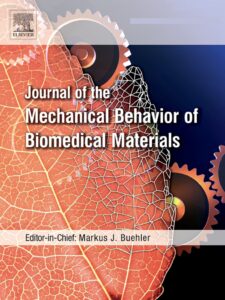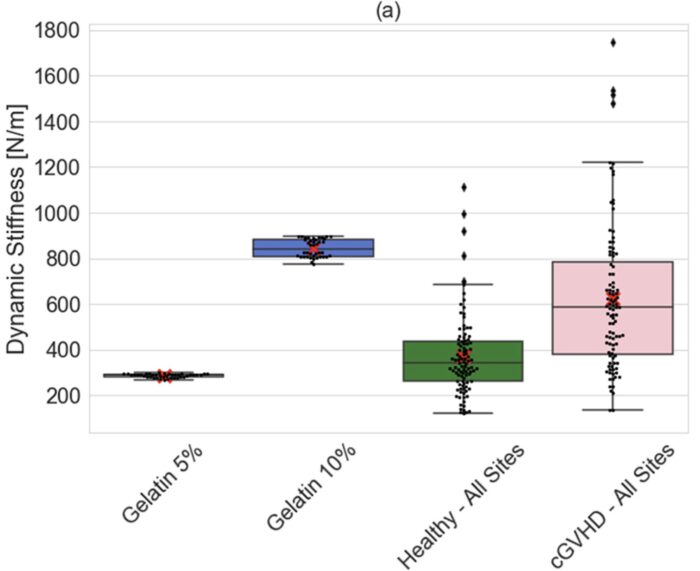Publications

mTG-Gelatin phantoms as standardized testbeds for skin biomechanical measurements with MyotonPRO
Authors: Shramana Ghosh 1, 2, John A. Rector 3, Inga Saknite 2, Hayden B. Smith 1, 2, 4, Kristy M. Walsh 5, Brett C. Byram 5, Leon M. Bellan 3, 5, Eric R. Tkaczyk 1, 2, 4, 5
Affiliations:
- Medicine Service and Research Service, Department of Veterans Affairs, Tennessee Valley Healthcare System, Nashville, TN, USA
- Department of Dermatology, Vanderbilt University Medical Center, Nashville, TN, USA
- Department of Mechanical Engineering, Vanderbilt University School of Engineering, Nashville, TN, USA
- Vanderbilt University School of Medicine, Nashville, TN, USA
- Department of Biomedical Engineering, Vanderbilt University School of Engineering, Nashville, TN, USA
Journal: Journal of the Mechanical Behavior of Biomedical Materials - July 2024, In Press, Article no. 106651 (DOI: 10.1016/j.jmbbm.2024.106651)
-
Field & Applications:
- Medical
- Skin / Dermatology
- Validity
- All five MyotonPRO parameters correlate well with material elasticity, enhancing confidence in the validity of MyotonPRO measurements.
- MyotonPRO was successfully able to distinguish changes in material properties of a bilayer phantom due to the presence of a stiffer 2 mm thin top layer, further supporting its suitability for performing skin measurements.
Quantitative assessment of skin mechanical properties can play a pivotal role in diagnosing and tracking various dermatological conditions. MyotonPRO is a promising tool that rapidly and noninvasively measures five skin biomechanical parameters. Accurate interpretation of these parameters requires systematic in vitro testing with easy-to-fabricate, cost-effective skin-mimicking phantoms with controllable properties.
In this study, we assessed the ability of phantoms made with 5% and 10% gelatin crosslinked with microbial transglutaminase (mTG) to mimic the human skin for MyotonPRO measurements. We discovered that each of the five MyotonPRO parameters displayed moderate to high correlations with shear elastic modulus of the phantoms. Furthermore, MyotonPRO effectively tracked changes in the mechanical properties of these models over time.
Additionally, we designed bilayer phantoms incorporating both dermis and subcutaneous tissue-mimicking layers. MyotonPRO successfully distinguished changes in the mechanical properties of the bilayer phantoms due to the introduction of a stiff 2 mm top layer. We also found that 5% mTG-gelatin phantoms mimic MyotonPRO measurements from healthy subjects and 10% phantoms mimic patients with sclerotic cGVHD. Therefore, multi-layered mTG-gelatin models for skin and soft tissues can serve as standardized testbeds to study different sclerotic skin conditions in a systematic manner.

Figure. mTG-Gelatin phantoms offer a reasonable approximation of healthy and sclerotic skin. The MyotonPRO dynamic stiffness measurements of 5% phantoms resembled those of healthy skin, whereas those of 10% phantoms resembled measurements taken of sclerotic skin.
Keywords: MyotonPRO, skin biomechanics, phantom, gelatin, shear rheology
In conclusion, 5% and 10% mTG-gelatin phantoms can mimic MyotonPRO measurements from healthy subjects and patients with sclerotic cGVHD. MyotonPRO measurements for these phantoms are well correlated with independently measured elastic modulus. MyotonPRO can also successfully track changes in phantom properties over time and distinguish changes in material properties within a thin top layer (∼2 mm) of a bilayer phantom. Multi-layered mTG-gelatin phantom models for skin and soft tissues can therefore serve as standardized testbeds to further study different sclerotic skin conditions in a systematic manner.


